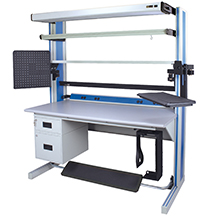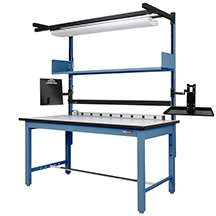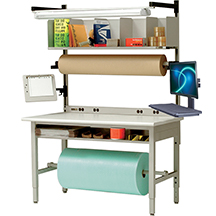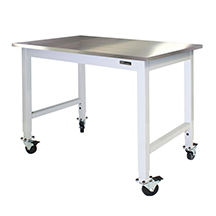What is Really Required to do This Task?
By Joy M. Ebben, Ph.D, CPE
Human Factors and Ergonomic Specialist, IAC, a Division of Treston, Brea, Calif.
Task analyses may identify potential causes of serious injury, or damage equipment.
As a new product design unfolds, so do the specifications for the hand tools, parts, computer systems, and software that a worker will use for assembly, test, and repair tasks. Typically, beyond identifying the tools to be used, no one analyzes what the operator is asked to do. What is expected? And to what performance criteria?
Contrast the dearth of human task analysis with the extensive amount of process planning analysis that goes into programming a machine to perform a visual inspection, or developing software to control a robotics system.
Reasons to analyze worker’s tasks include detecting potential errors, or where unacceptable performance rates may occur. Analyses may also identify potential causes of serious injury, or damage equipment. With such information, recommendations can be developed for correcting the product design, tools, or manufacturing process.
Additionally, a good understanding of a task can guide personnel selection and planning for personnel training. An analysis can help define job descriptions, or indicate “reasonable accommodations” required by the Americans with Disabilities Act, allowing a disabled worker to perform the task.
Generally, task analysis is an iterative process. The design process feeds into the task analysis. It, in turn, drives changes to the evolving product design, which alters the task analysis. This leads to changes in personnel or training requirements, and enhanced definitions for job aids and tools. A result can be fewer production start-up problems.
Analysis Methods
Methods of task analysis vary according to their purpose. Diagnostic tasks may require extensive analysis of cognitive requirements—decision making, memory, and analytical thinking—while an inspection task will delve more thoroughly into visual acuity requirements.
An analysis of a structured assembly task generally includes an action statement, results of the action, tools used, human abilities and skills—cognitive, perceptual, motor, strength, and knowledge—required to perform the task, and environmental conditions such as heat, vibration, cold, and humidity. Sometimes protective clothing requirements become a key element.
How Simple Is The Task?
The level of detail in analysis must serve its purpose. For example, inserting and tightening a screw can take several steps. They include identifying the correct screw and tool, positioning the screw and tool, tightening the screw, stopping tightening, and storing the tool. After the steps are determined, the analyst then asks what abilities are required at each step.
If a person’s task involves five different screws, how will he identify the correct one? By sight, or by touch? Will low-level lighting, or restricted vision due to protective eye gear interfere? What if the operator’s visual attention should focus elsewhere?
Will storage location on the work surface affect screw identification? Will gloves make tactical discrimination difficult? Are the various screws used by an operator similar enough so that one used in error during manufacturing might cause a failure in the field?
Do the screws need to be identified (a cognitive task) without using a comparison screw or template/what motor control is required to retrieve and position the screw and use the screwing tool?
Is there a physical guide to help position the screw and tool? How does the operator know when the screw is sufficiently tight? What skills are required to determine “tightness” and what metrics are used? What about corrective procedures if a screw is over-tightened? How does the operator know when the task is properly completed? The list of potential questions goes on.
Analyzing a “simple” task can have complex consequences. Estimating human error can lead to recommendations for streamlining the process. Examples include: reducing different screw sizes, increasing the differences in screw sizes to improve visual and/or tactical discrimination, sorting screws by size to decrease the number of discriminations required, providing better lighting, or strategically locating the screws on the work surface.
 Buy Online Now!
Buy Online Now!
 Buy Online Now!
Buy Online Now!











